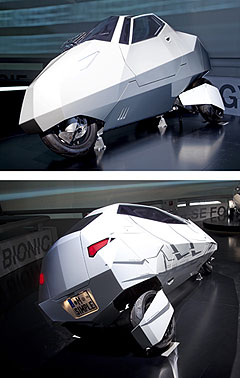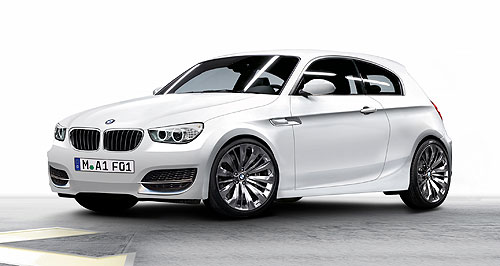Make / Model Search
Future models - BMW - i3BMW Megacity set to be a super lightweight championCarbon copy: The BMW Megacity will swap heavy metal for light carbon-fibre to save weight. Digital image: Chris Harris. ‘Simple’ concept points to carbon-fibre construction for BMW’s urban EV27 Nov 2009 By TERRY MARTIN BMW’s forthcoming Megacity electric vehicle and other urban-oriented models from its ‘Project i’ skunkworks will make extensive use of lightweight carbon-fibre components, drawing from a new joint venture and being demonstrated via an offbeat concept car known as ‘Simple’. While overseas reports this week have indicated that Renault and Daimler are having talks over a partnership with their next-generation urban vehicles – a move that could see the French manufacturer’s Twizy and Zoe models using Smart-based underpinnings and powertrains – BMW has forged an alliance with the SGL Group that will result in an investment of €90 million ($A148.7 million in the development phase of the carbon-fibre program. In announcing the deal, BMW AG chief executive Norbert Reithofer said that, as a result, the production version of the Megacity, which is due for release early next decade, will use “large quantities of extremely stable, lightweight carbon-fibre components”. “This joint venture is designed to be a classic win-win situation,” Dr Reithofer said. “We are acquiring pioneering future technologies and raw materials that we need for our Megacity vehicle on competitive terms. “With our concepts within Project i, we are breaking new ground when it comes to vehicle architecture, lightweight design and the use of materials.”  Left: BMW Simple concept. Left: BMW Simple concept.Drawing on similar themes to Renault’s Twizy, BMW’s slim two-seater Simple concept stands for ‘Sustainable and Innovative Mobility Product for Low Energy consumption’ and makes extensive use of strong, lightweight materials and components. The 110cm-wide Simple has a kerb weight of 450kg – about the same as the Twizy – and, like Nissan’s LandGlider concept (which is understood to be related to the Twizy), it can tilt during cornering. “In contrast to other vehicle concepts in which only the passenger cell tilts during cornering, here all the driver has to do is determine a change in direction for the appropriate tilt to follow automatically,” BMW said. “The stand-out feature of the Simple concept is that it activates the hydraulics only in exceptional situations, for example if the vehicle threatens to become unstable during extremely slow driving, when righting the vehicle during standstill or in extreme situations such as drifting. “Otherwise, Simple rides like a motorcycle and, beyond natural gravity and gyroscopic forces, requires no energy whatsoever to lean into a corner.” Rather than being shown as a full-electric vehicle, the Simple has emerged as a petrol-electric hybrid that combines a 36kW combustion engine with an electric motor. BMW estimates acceleration from 0-100km/h at less than 10 seconds for the vehicle, which has a drag coefficient of just 0.18Cd. Using the electric motor and the combustion engine, the Simple would, according to the manufacturer, need just 6kWh (equivalent to 0.7 litres of petrol) or two litres over 100km. While BMW already uses hi-tech carbon-fibre reinforced plastic (CFRP) in production models, such as in the roof of the M6 Coupe, it said the deal with SGL makes it possible, for the first time, to install CFRP on a large scale in a series model at a competitive cost. “In the Megacity vehicle, which will be launched under a BMW sub-brand in the first half of the next decade, the high-strength yet ultra-light material will make up a significant proportion of the materials used,” the company said. “With the joint venture, the BMW Group is underlining its position as the most sustainable vehicle manufacturer. This claim is reflected throughout the entire value creation chain, from component purchasing to recycling.” The carbon fibres will be made in the US, with processing of the raw material into a carbon-fibre fabric in Germany. Parts and components will then be made from this lightweight, durable fabric within the BMW Group. SGL Group chief executive Robert Koehler said: “This joint venture with the BMW Group is a milestone for the use of carbon fibres on an industrial scale in the automobile industry. For the first time, carbon fibres are taking on an important role in series vehicle manufacture. “This confirms our strategy and shows that carbon fibre technology is becoming increasingly important in the materials substitution process to lighter material. This material will help to reduce CO2 emissions and save our natural resources.” In announcing BMW AG’s third-quarter financial results earlier this month, Dr Reithofer identified new mobility concepts, including the Megacity, as models that would “ensure the BMW Group’s future”. “We remain a long-term-oriented company in the premium segment for individual mobility,” he said. “Within our ‘Strategy Number One’, we have analysed future trends in mobility. We know where we want to go.” Dr Reithofer also made reference to the use of more modular platforms within the group. “Our new models and the renewal of our high-volume series over the next few years will lead to greater efficiency potential,” he said. “For instance, through a more modular concept. We have found synergies across model series. This should also enhance the value of our cars. The quality of our products remains our top priority. “We will be able to reduce material costs by 2012 much more than originally planned. The steps already taken have allowed us to secure substantial long-term cost benefits.”  Read more30th of August 2009  First look: BMW reveals plug-in diesel super-coupeWacky coupe concept heralds first plug-in hybrid and three-cylinder oiler from BMW7th of August 2009  BMW to launch own-label eco brandBMW to market its Megacity electric car and other green vehicles under new sub-brandAll future models Alfa Romeo Alfa Romeo Abarth Abarth Alpine Alpine Alpina Alpina Audi Audi Aston Martin Aston Martin BMW BMW Bentley Bentley Chery Chery Brabham Brabham Chrysler Chrysler Chevrolet Chevrolet Cupra Cupra Citroen Citroen DS DS Dodge Dodge Fiat Fiat Ferrari Ferrari Foton Foton Ford Ford Great Wall Great Wall FPV FPV Haval Haval GWM GWM Honda Honda Holden Holden Hummer Hummer HSV HSV Infiniti Infiniti Hyundai Hyundai Jaguar Jaguar Isuzu Isuzu Kia Kia Jeep Jeep Land Rover Land Rover Lamborghini Lamborghini Lexus Lexus LDV LDV Mahindra Mahindra Lotus Lotus Mazda Mazda Maserati Maserati Mercedes-AMG Mercedes-AMG McLaren McLaren MG MG Mercedes-Benz Mercedes-Benz Mitsubishi Mitsubishi Mini Mini Opel Opel Nissan Nissan Peugeot Peugeot Pagani Pagani Proton Proton Porsche Porsche Renault Renault Ram Ram Rover Rover Rolls-Royce Rolls-Royce Skoda Skoda Saab Saab SsangYong SsangYong Smart Smart Suzuki Suzuki Subaru Subaru Toyota Toyota Tesla Tesla Volvo Volvoi3 pricing
Motor industry news |
Click to shareBMW modelsResearch BMW All future models Alfa Romeo Alfa Romeo Abarth Abarth Alpine Alpine Alpina Alpina Audi Audi Aston Martin Aston Martin BMW BMW Bentley Bentley Chery Chery Brabham Brabham Chrysler Chrysler Chevrolet Chevrolet Cupra Cupra Citroen Citroen DS DS Dodge Dodge Fiat Fiat Ferrari Ferrari Foton Foton Ford Ford Great Wall Great Wall FPV FPV Haval Haval GWM GWM Honda Honda Holden Holden Hummer Hummer HSV HSV Infiniti Infiniti Hyundai Hyundai Jaguar Jaguar Isuzu Isuzu Kia Kia Jeep Jeep Land Rover Land Rover Lamborghini Lamborghini Lexus Lexus LDV LDV Mahindra Mahindra Lotus Lotus Mazda Mazda Maserati Maserati Mercedes-AMG Mercedes-AMG McLaren McLaren MG MG Mercedes-Benz Mercedes-Benz Mitsubishi Mitsubishi Mini Mini Opel Opel Nissan Nissan Peugeot Peugeot Pagani Pagani Proton Proton Porsche Porsche Renault Renault Ram Ram Rover Rover Rolls-Royce Rolls-Royce Skoda Skoda Saab Saab SsangYong SsangYong Smart Smart Suzuki Suzuki Subaru Subaru Toyota Toyota Tesla Tesla Volvo Volvoi3 pricing
Motor industry news |











Facebook Twitter Instagram